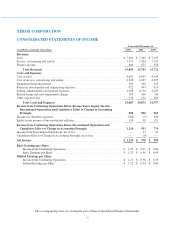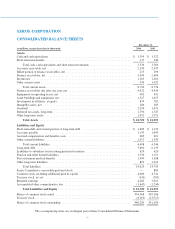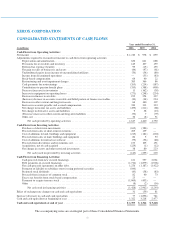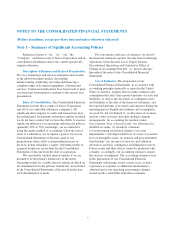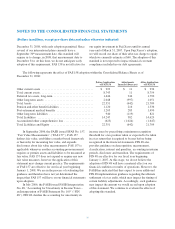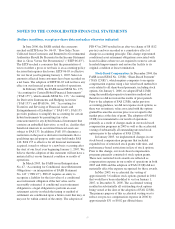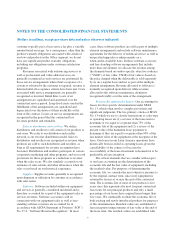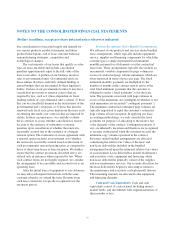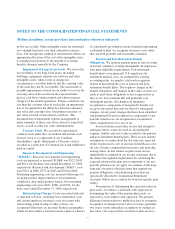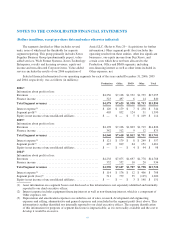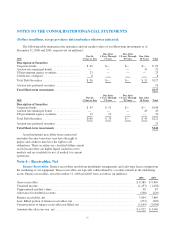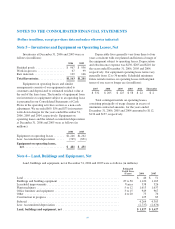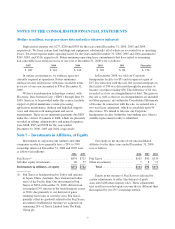Xerox 2006 Annual Report Download - page 62
Download and view the complete annual report
Please find page 62 of the 2006 Xerox annual report below. You can navigate through the pages in the report by either clicking on the pages listed below, or by using the keyword search tool below to find specific information within the annual report.NOTES TO THE CONSOLIDATED FINANCIAL STATEMENTS
(Dollars in millions, except per-share data and unless otherwise indicated)
due consideration to forecasted supply and demand for
our various products, product retirement and future
product launch plans, end of lease customer behavior,
remanufacturing strategies, competition and
technological changes.
The vast majority of our leases that qualify as sales-
type are non-cancelable and include cancellation
penalties approximately equal to the full value of the
lease receivables. A portion of our business involves
sales to governmental units. Governmental units are
those entities that have statutorily defined funding or
annual budgets that are determined by their legislative
bodies. Certain of our governmental contracts may have
cancellation provisions or renewal clauses that are
required by law, such as 1) those dependant on fiscal
funding outside of a governmental unit’s control, 2) those
that can be cancelled if deemed in the best interest of the
governmental unit’s taxpayers or 3) those that must be
renewed each fiscal year, given limitations that may exist
on entering into multi-year contracts that are imposed by
statute. In these circumstances, we carefully evaluate
these contracts to assess whether cancellation is remote
because of the existence of substantive economic
penalties upon cancellation or whether the renewal is
reasonably assured due to the existence of a bargain
renewal option. The evaluation of a lease agreement with
a renewal option includes an assessment as to whether
the renewal is reasonably assured based on the intent of
such governmental unit and pricing terms as compared to
those of short-term leases at lease inception. We further
ensure that the contract provisions described above are
offered only in instances where required by law. Where
such contract terms are not legally required, we consider
the arrangement to be cancelable and account for it as an
operating lease.
After the initial lease of equipment to our customers,
we may enter subsequent transactions with the same
customer whereby we extend the term. Revenue from
such lease extensions is typically recognized over the
extension period.
Revenue Recognition Under Bundled Arrangements:
We sell most of our products and services under bundled
lease arrangements, which typically include equipment,
service, supplies and financing components for which the
customer pays a single negotiated fixed minimum
monthly payment for all elements over the contractual
lease term. These arrangements typically also include an
incremental, variable component for page volumes in
excess of contractual page volume minimums, which are
often expressed in terms of price per page. The fixed
minimum monthly payments are multiplied by the
number of months in the contract term to arrive at the
total fixed minimum payments that the customer is
obligated to make (“fixed payments”) over the lease
term. The payments associated with page volumes in
excess of the minimums are contingent on whether or not
such minimums are exceeded (“contingent payments”).
The minimum contractual committed page volumes are
typically negotiated to equal the customer’s estimated
page volume at lease inception. In applying our lease
accounting methodology, we only consider the fixed
payments for purposes of allocating to the relative fair
value elements of the contract. Contingent payments, if
any, are inherently uncertain and therefore are recognized
as revenue in the period when the customer exceeds the
minimum copy volumes specified in the contract.
Revenues under bundled arrangements are allocated
considering the relative fair values of the lease and
non-lease deliverables included in the bundled
arrangement based upon the estimated relative fair values
of each element. Lease deliverables include maintenance
and executory costs, equipment and financing, while
non-lease deliverables generally consist of the supplies
and non-maintenance services. Our revenue allocation for
the lease deliverables begins by allocating revenues to
the maintenance and executory costs plus profit thereon.
The remaining amounts are allocated to the equipment
and financing elements.
Cash and Cash Equivalents: Cash and cash
equivalents consist of cash on hand, including money-
market funds, and investments with original maturities of
three months or less.
60


